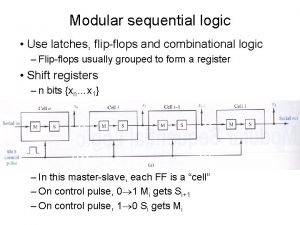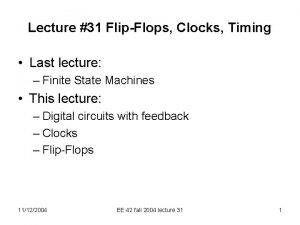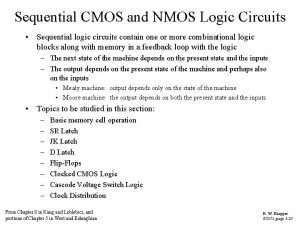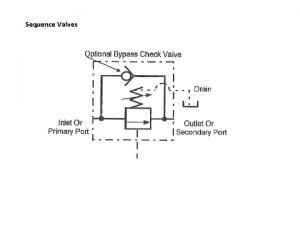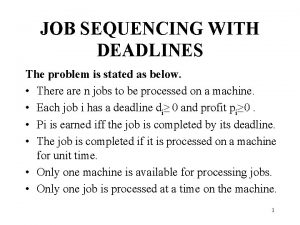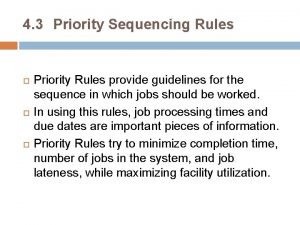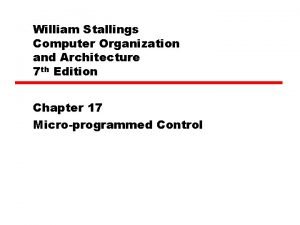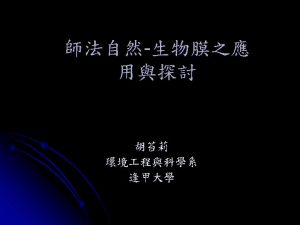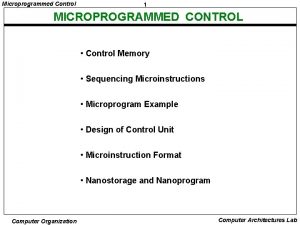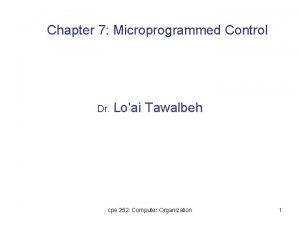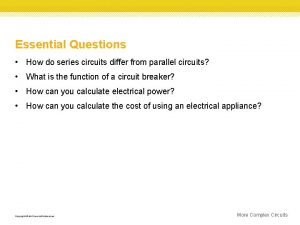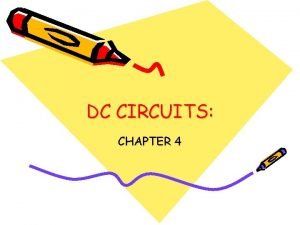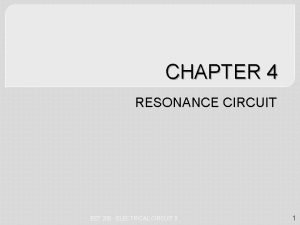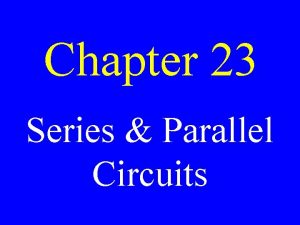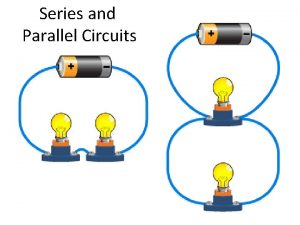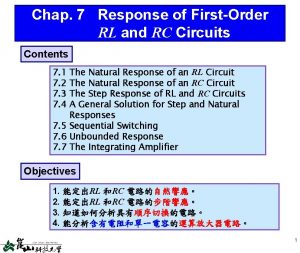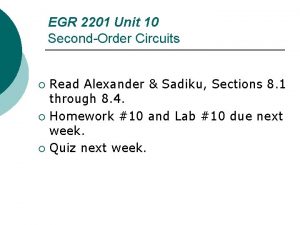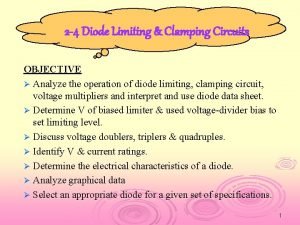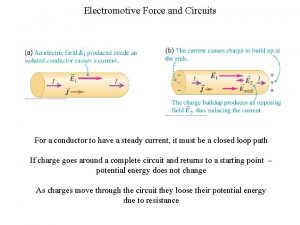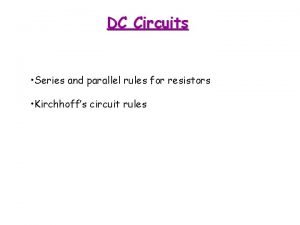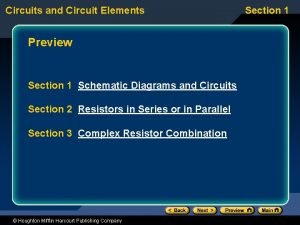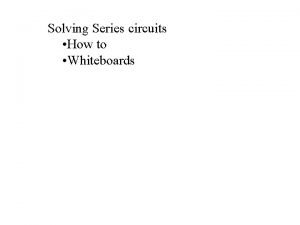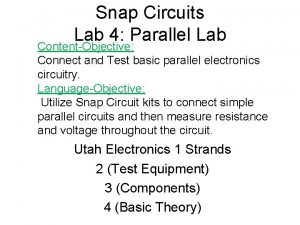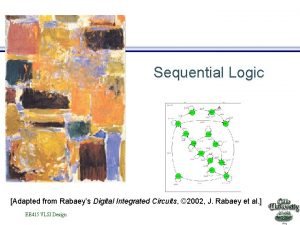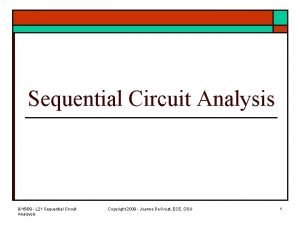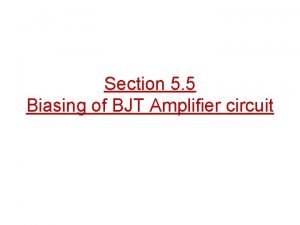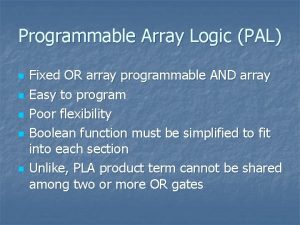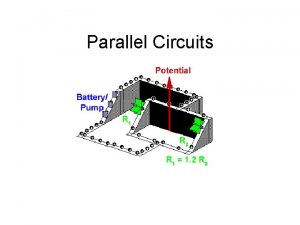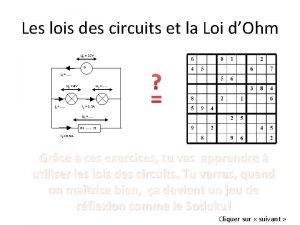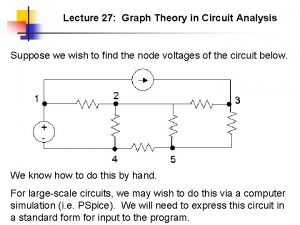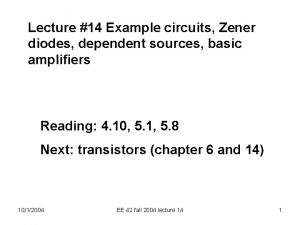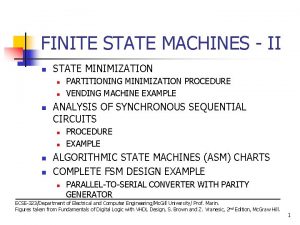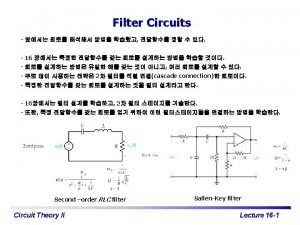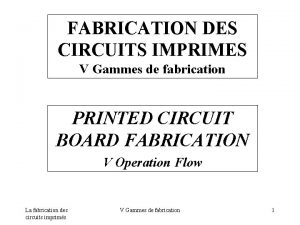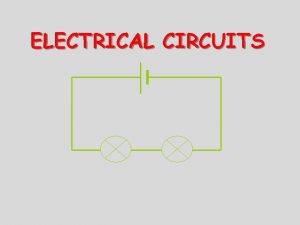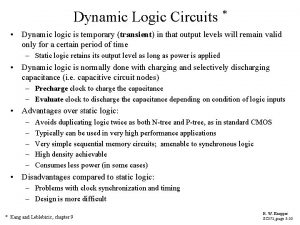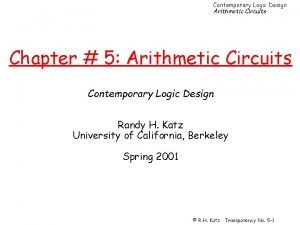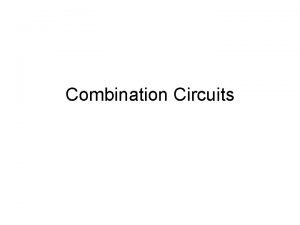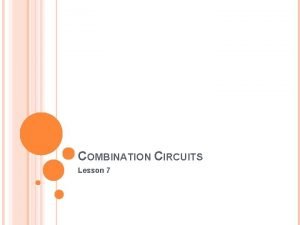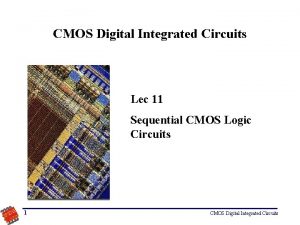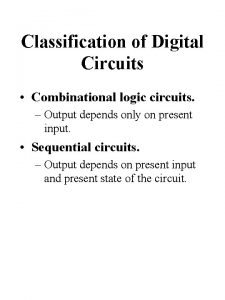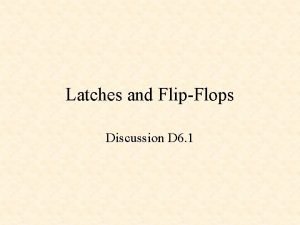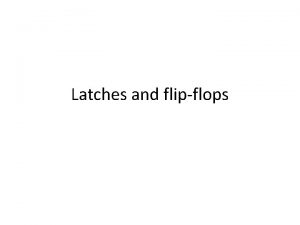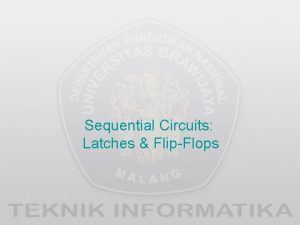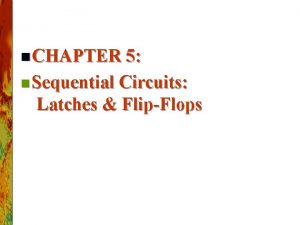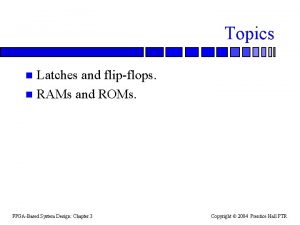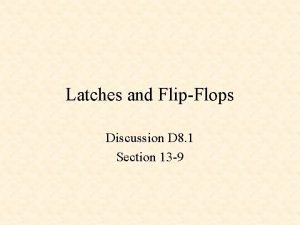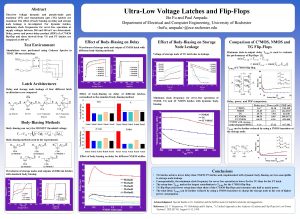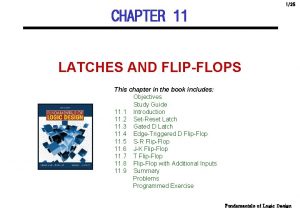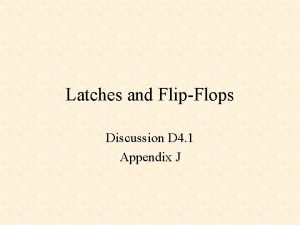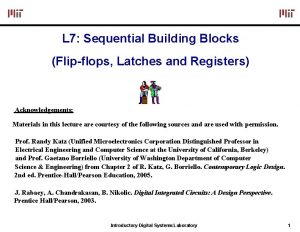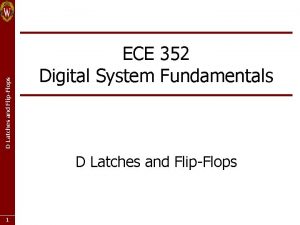Sequencing Static Circuits latches and flipflops are the














































































































































































![] • The contamination delay and propagation delay y be very different because of ] • The contamination delay and propagation delay y be very different because of](https://slidetodoc.com/presentation_image_h/0a3d375a98b882bb62702d5ca63b488a/image-175.jpg)


![]]] • Ideally, the entire clock cycle would be available for computations in the ]]] • Ideally, the entire clock cycle would be available for computations in the](https://slidetodoc.com/presentation_image_h/0a3d375a98b882bb62702d5ca63b488a/image-178.jpg)










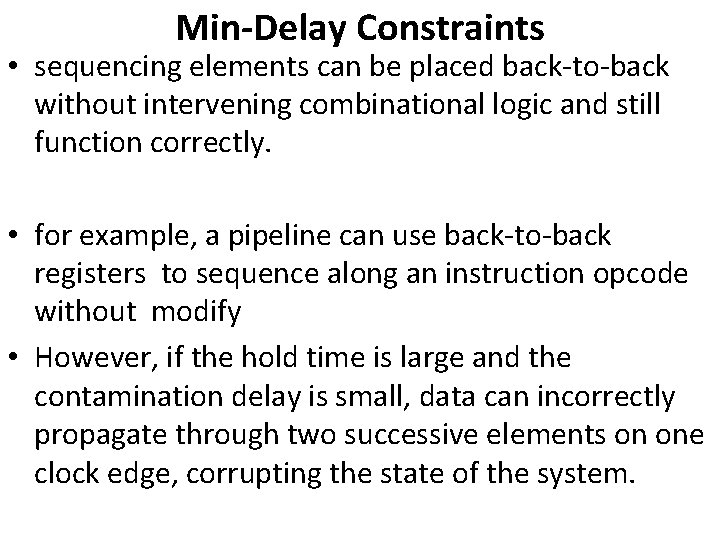
![• This is ]]called a race condition, hold-time failure, or min-delay failure. • • This is ]]called a race condition, hold-time failure, or min-delay failure. •](https://slidetodoc.com/presentation_image_h/0a3d375a98b882bb62702d5ca63b488a/image-190.jpg)
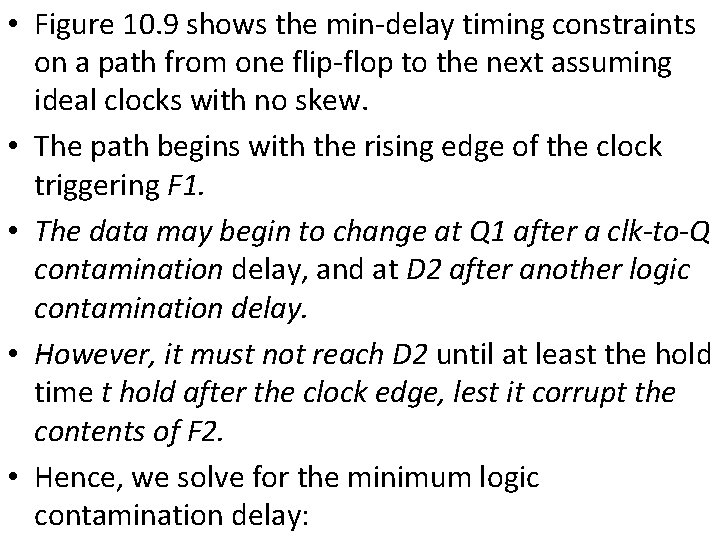

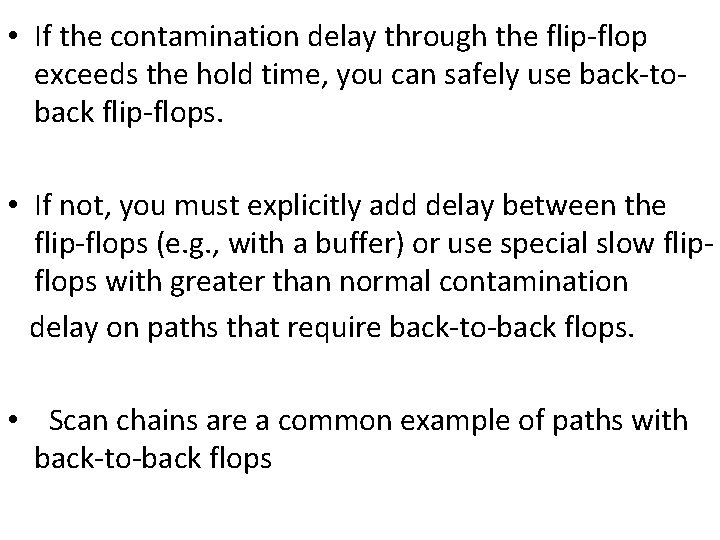
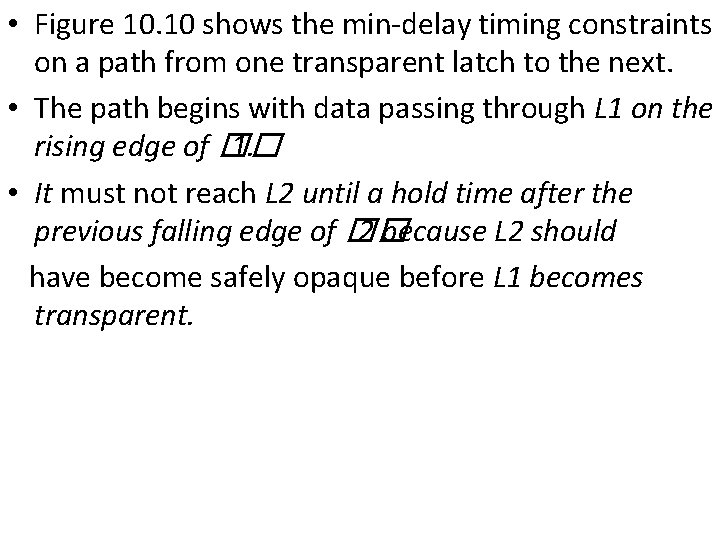

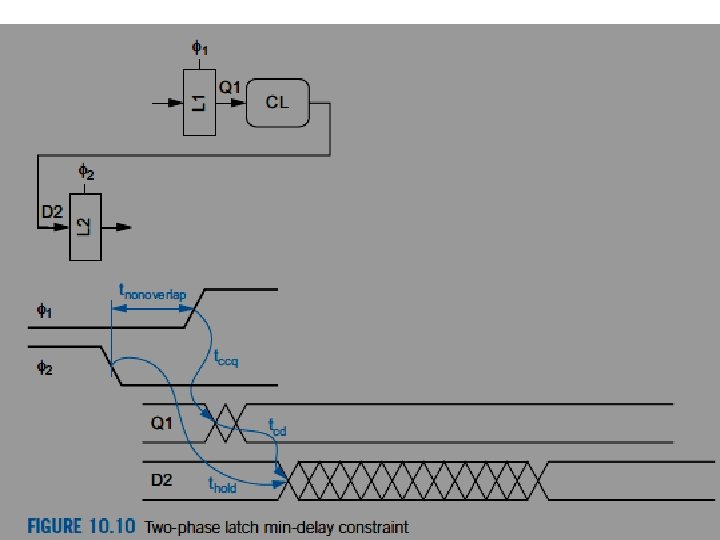
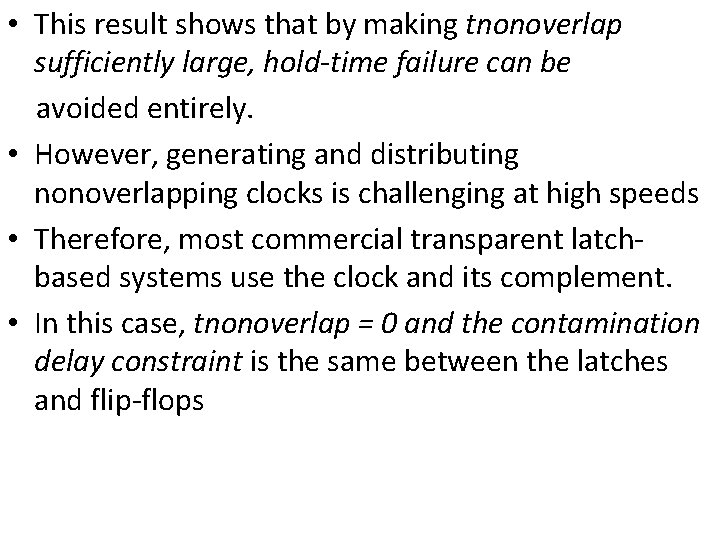
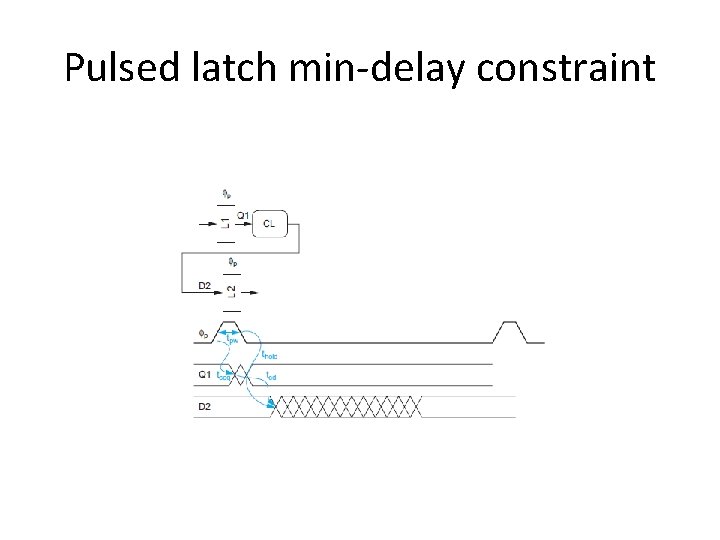
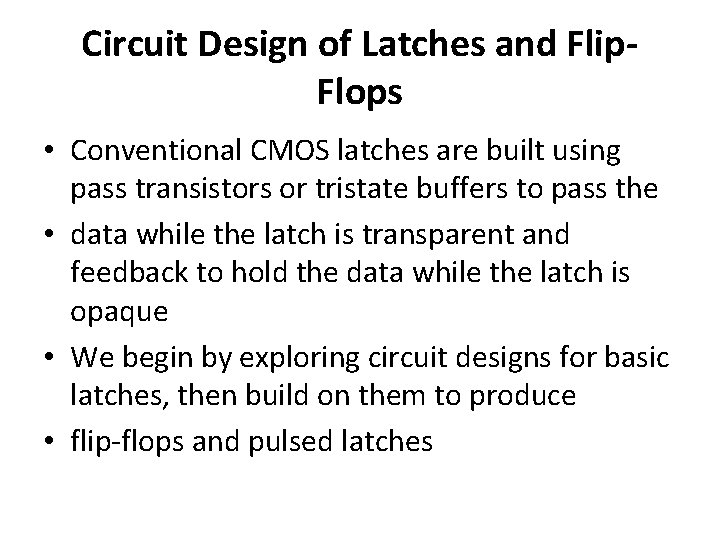
- Slides: 199






























































































































































Sequencing Static Circuits • latches and flip-flops are the two most commonly used sequencing elements. • Both have three terminals: data input (D), clock (clk), and data output (Q). • The latch is transparent when the clock is high and opaque when the clock is low; in other words, when the clock is high, D flows through to Q as if the latch were just a buffer, but when the clock is low, the latch holds its present Q output even if D changes.

• The flip-flop is an edge-triggered device that copies D to Q on the rising edge of the clock and ignores D at all other times. These are illustrated in Figure 10. 1. • The unknown state of Q before the first rising clock edge is indicated by the pair of lines at both low and high levels.


• An ideal sequencing methodology would introduce 1. no sequencing overhead, allow sequencing elements back-to-back with no logic in between 2. grant the designer flexibility in balancing the amount of logic in each clock cycle 3. tolerate moderate amounts of clock skew without degrading performance, and consume zero area and power

Sequencing Methods

• Figure 10. 2 illustrates three methods of sequencing blocks of combinational logic. • In each case, the clock waveforms, sequencing elements, and combinational logic are shown. • The horizontal axis corresponds to the time at which a token reaches a point in the circuit. • For example, the token is captured in the first flipflop on the first rising edge of the clock.

• It propagates through the combinational logic and reaches the second flip-flop on the second rising edge of the clock. • The dashed vertical lines indicate the boundary between one clock cycle and the next. • The clock period is Tc. • In a 2 -phase system, the phases may be separated by t nonoverlap. • In a pulsed system, the pulse width is tpw.

• Flip-flop-based systems use one flip-flop on each cycle boundary. • Tokens advance from one cycle to the next on the rising edge. • If a token arrives too early, it waits at the flip-flop until the next cycle. • Recall that the flip-flop can be viewed as a pair of back-to back latches using clk and its complement


• Flip-flop-based systems use one flip-flop on each cycle boundary. • Tokens advance from one cycle to the next on the rising edge. • If a token arrives too early, it waits at the flip-flop until the next cycle. • Recall that the flip-flop can be viewed as a pair of back-toback latches using clk and its complement, as shown in Figure 10. 3. •

• If we separate the latches, we can divide the full cycle of combinational logic into two phases, sometimes half-cycles. • The two latch clocks are often called and. They may correspond to clk and its complement clk or may be nonoverlapping (tnonoverlap > 0). • A t any given time, at least one clock is low and the corresponding latch is opaque, preventing one token from catching up with another.


• Table 10. 1 defines the delays and timing constraints of the combinational logic and sequencing elements. • These delays may differ significantly for rising and falling transitions and can be distinguished with an r or f suffix. For brevity, we will use the overall maximum and minimum.

Figure 10. 4 illustrates these delays in a timing diagram • In a timing diagram, the horizontal axis indicates time and the vertical axis indicates logic level. • A single line indicates that a signal is high or low at that time. • A pair of lines indicates that a signal is stable but that we don’t care about its value. • In a timing diagram, the horizontal axis indicates time and the vertical axis indicates logic level. • A single line indicates that a signal is high or low at that time.

• A pair of lines indicates that a signal is stable but that we don’t care about its value. • Criss-crossed lines indicate that the signal might change at that time. • A pair of lines with cross-hatching indicates that the signal may change once or more over an interval of time.


• Figure 10. 4(a) shows the response of combinational logic to the input A changing from one arbitrary value to another • The output Y cannot change instantaneously. • After the contamination delay tcd , Y may begin to change or glitch. • After the propagation delay tpd, Y must have settled to a final value.
![The contamination delay and propagation delay y be very different because of ] • The contamination delay and propagation delay y be very different because of](https://slidetodoc.com/presentation_image_h/0a3d375a98b882bb62702d5ca63b488a/image-175.jpg)
] • The contamination delay and propagation delay y be very different because of multiple paths through the combinational logic. • Figure. 4(b) shows the response of a flip-flop. • The data input must be stable for some window around the rising edge of the flop if it is to be reliably sampled • Specifically, the input D must have settled by some setup time tsetup before the rising edge of clk and should not change again until a hold time thold after the clock edge

• The output begins to change after a clock-to-Q contamination delay tccq and completely settles after a clock-to-Q propagation delay tpcq. • Figure 10. 4(c) shows the response of a latch. • Now the input D must set up and hold around the falling edge that defines the end of the sampling period. • The output initially changes tccq after the latch becomes transparent on the rising edge of the clock and settles by tpcq. • While the latch is transparent, the output will continue to track the input after some D-to-Q delay tcdq and tpdq

Max-Delay Constraints
![Ideally the entire clock cycle would be available for computations in the ]]] • Ideally, the entire clock cycle would be available for computations in the](https://slidetodoc.com/presentation_image_h/0a3d375a98b882bb62702d5ca63b488a/image-178.jpg)
]]] • Ideally, the entire clock cycle would be available for computations in the combinational logic. • seqencing overhead of the latches or flip-flops cuts into this time. • If the combinational logic delay is too great, the receiving element will miss its setup time and sample the wrong value.

• This is called a setup time failure or max-delay failure. • It can be solved by redesigning the logic to be faster or by increasing the clock period. • This section computes the actual time available for logic and the sequencing overhead of each of our favorite sequencing elements: flip-flops, two-phase latches, and pulsed latches

• Figure 10. 5 shows the max-delay timing constraints on a path from one flip-flop to the next, assuming ideal clocks with no skew. • The path begins with the rising edge of the clock triggering F 1. • The data must propagate to the output of the flipflop Q 1 and through the combinational logic to D 2, setting up at F 2 before the next rising clock edge. • This implies that the clock period must be at least


Figure 10. 7 shows the analogous constraint on latches

• . Certain paths may take longer if other paths take less time; this technique is called time borrowing Assuming the path takes no more than a cycle, we see the cycle time must be

• Once again, we can solve for the maximum logic delay, which is the sum of the logic delays through each of the two phases. • The sequencing overhead consists of the two latch propagation delays. Notice that the nonoverlap between clocks does not degrade performance in the latch-based system because data continues to propagate through the combinational logic between latches even while both clocks are low.

• Realizing that a flip-flop can be made from two latches whose delays determine the flop propagation delay and setup time, we see EQ (10. 4) is closely analogous to EQ (10. 2).

• The max-delay constraint for pulsed latches is similar to that of two-phase latches except that only one latch is in the critical path, as shown in Figure 10. 8(a). • However, if the pulse is narrower than the setup time, the data must set up before the pulse rises, as shown in Figure 10. 8(b). • Combining these two cases gives



Min-Delay Constraints • sequencing elements can be placed back-to-back without intervening combinational logic and still function correctly. • for example, a pipeline can use back-to-back registers to sequence along an instruction opcode without modify • However, if the hold time is large and the contamination delay is small, data can incorrectly propagate through two successive elements on one clock edge, corrupting the state of the system.
![This is called a race condition holdtime failure or mindelay failure • This is ]]called a race condition, hold-time failure, or min-delay failure. •](https://slidetodoc.com/presentation_image_h/0a3d375a98b882bb62702d5ca63b488a/image-190.jpg)
• This is ]]called a race condition, hold-time failure, or min-delay failure. • It can only be fixed by redesigning the logic, not by slowing the clock. • Therefore, designers should be very conservative in avoiding such failures because modifying and refabricating a chip is catastrophically expensive and time-consuming.

• Figure 10. 9 shows the min-delay timing constraints on a path from one flip-flop to the next assuming ideal clocks with no skew. • The path begins with the rising edge of the clock triggering F 1. • The data may begin to change at Q 1 after a clk-to-Q contamination delay, and at D 2 after another logic contamination delay. • However, it must not reach D 2 until at least the hold time t hold after the clock edge, lest it corrupt the contents of F 2. • Hence, we solve for the minimum logic contamination delay:


• If the contamination delay through the flip-flop exceeds the hold time, you can safely use back-toback flip-flops. • If not, you must explicitly add delay between the flip-flops (e. g. , with a buffer) or use special slow flipflops with greater than normal contamination delay on paths that require back-to-back flops. • Scan chains are a common example of paths with back-to-back flops

• Figure 10. 10 shows the min-delay timing constraints on a path from one transparent latch to the next. • The path begins with data passing through L 1 on the rising edge of �� 1. • It must not reach L 2 until a hold time after the previous falling edge of �� 2 because L 2 should have become safely opaque before L 1 becomes transparent.

• As the edges are separated by tnonoverlap, the minimum logic contamination delay through each phase of logic is


• This result shows that by making tnonoverlap sufficiently large, hold-time failure can be avoided entirely. • However, generating and distributing nonoverlapping clocks is challenging at high speeds • Therefore, most commercial transparent latchbased systems use the clock and its complement. • In this case, tnonoverlap = 0 and the contamination delay constraint is the same between the latches and flip-flops

Pulsed latch min-delay constraint

Circuit Design of Latches and Flip. Flops • Conventional CMOS latches are built using pass transistors or tristate buffers to pass the • data while the latch is transparent and feedback to hold the data while the latch is opaque • We begin by exploring circuit designs for basic latches, then build on them to produce • flip-flops and pulsed latches
 Mikael ferm
Mikael ferm Standard logic latches
Standard logic latches Flipflops
Flipflops Gated d-latch
Gated d-latch What is the difference between latches and flip flops
What is the difference between latches and flip flops T flip flop excitation table
T flip flop excitation table Sr latch cmos
Sr latch cmos Latch s-r
Latch s-r Advantages of parallel circuits over series circuits
Advantages of parallel circuits over series circuits Sequence selection and iteration
Sequence selection and iteration Microprogrammed control
Microprogrammed control Loading sequencing and scheduling
Loading sequencing and scheduling Difference between ngs and sanger sequencing
Difference between ngs and sanger sequencing Conditional and iterative statements
Conditional and iterative statements Sequencing selection and iteration
Sequencing selection and iteration Sequencing strategies and tactics
Sequencing strategies and tactics Cloning and sequencing explorer series
Cloning and sequencing explorer series Sequencing batch reactor advantages and disadvantages
Sequencing batch reactor advantages and disadvantages Hình ảnh bộ gõ cơ thể búng tay
Hình ảnh bộ gõ cơ thể búng tay Frameset trong html5
Frameset trong html5 Bổ thể
Bổ thể Tỉ lệ cơ thể trẻ em
Tỉ lệ cơ thể trẻ em Gấu đi như thế nào
Gấu đi như thế nào Chụp tư thế worms-breton
Chụp tư thế worms-breton Alleluia hat len nguoi oi
Alleluia hat len nguoi oi Môn thể thao bắt đầu bằng chữ f
Môn thể thao bắt đầu bằng chữ f Thế nào là hệ số cao nhất
Thế nào là hệ số cao nhất Các châu lục và đại dương trên thế giới
Các châu lục và đại dương trên thế giới Cong thức tính động năng
Cong thức tính động năng Trời xanh đây là của chúng ta thể thơ
Trời xanh đây là của chúng ta thể thơ Mật thư anh em như thể tay chân
Mật thư anh em như thể tay chân Làm thế nào để 102-1=99
Làm thế nào để 102-1=99 Phản ứng thế ankan
Phản ứng thế ankan Các châu lục và đại dương trên thế giới
Các châu lục và đại dương trên thế giới Thơ thất ngôn tứ tuyệt đường luật
Thơ thất ngôn tứ tuyệt đường luật Quá trình desamine hóa có thể tạo ra
Quá trình desamine hóa có thể tạo ra Một số thể thơ truyền thống
Một số thể thơ truyền thống Bàn tay mà dây bẩn
Bàn tay mà dây bẩn Vẽ hình chiếu vuông góc của vật thể sau
Vẽ hình chiếu vuông góc của vật thể sau Thế nào là sự mỏi cơ
Thế nào là sự mỏi cơ đặc điểm cơ thể của người tối cổ
đặc điểm cơ thể của người tối cổ V cc
V cc Vẽ hình chiếu đứng bằng cạnh của vật thể
Vẽ hình chiếu đứng bằng cạnh của vật thể Fecboak
Fecboak Thẻ vin
Thẻ vin đại từ thay thế
đại từ thay thế điện thế nghỉ
điện thế nghỉ Tư thế ngồi viết
Tư thế ngồi viết Diễn thế sinh thái là
Diễn thế sinh thái là Dot
Dot Các số nguyên tố
Các số nguyên tố Tư thế ngồi viết
Tư thế ngồi viết Lời thề hippocrates
Lời thề hippocrates Thiếu nhi thế giới liên hoan
Thiếu nhi thế giới liên hoan ưu thế lai là gì
ưu thế lai là gì Khi nào hổ mẹ dạy hổ con săn mồi
Khi nào hổ mẹ dạy hổ con săn mồi Sự nuôi và dạy con của hươu
Sự nuôi và dạy con của hươu Hệ hô hấp
Hệ hô hấp Từ ngữ thể hiện lòng nhân hậu
Từ ngữ thể hiện lòng nhân hậu Thế nào là mạng điện lắp đặt kiểu nổi
Thế nào là mạng điện lắp đặt kiểu nổi Networks and graphs: circuits, paths, and graph structures
Networks and graphs: circuits, paths, and graph structures Euler and hamilton paths and circuits
Euler and hamilton paths and circuits Pros and cons of series and parallel circuits
Pros and cons of series and parallel circuits Sequencing ap csp
Sequencing ap csp Nhlbi exome sequencing project
Nhlbi exome sequencing project Sequential essay
Sequential essay Sequencing valve symbol
Sequencing valve symbol The order in which things happen is called
The order in which things happen is called Johnson's rule of sequencing
Johnson's rule of sequencing Sam file
Sam file Johnson's rule of sequencing
Johnson's rule of sequencing Job sequencing with deadlines algorithm
Job sequencing with deadlines algorithm Reversible terminator
Reversible terminator The cask of amontillado quiz
The cask of amontillado quiz Signing naturally page 250 answers
Signing naturally page 250 answers 5.9 commonly fingerspelled words
5.9 commonly fingerspelled words Per partes
Per partes Hierarchical shotgun sequencing vs whole genome
Hierarchical shotgun sequencing vs whole genome Rooster's off to see the world sequencing
Rooster's off to see the world sequencing History of sequencing
History of sequencing Sanger
Sanger Hierarchical shotgun sequencing vs whole genome
Hierarchical shotgun sequencing vs whole genome Dna
Dna History of sequencing
History of sequencing Are you my mother sequencing cards
Are you my mother sequencing cards Critical ratio rule
Critical ratio rule Address sequencing in computer architecture
Address sequencing in computer architecture Sequencing suki
Sequencing suki Greedy algorithm for job sequencing with deadlines
Greedy algorithm for job sequencing with deadlines Sequencing batch reactor
Sequencing batch reactor Panfacial fractures sequencing
Panfacial fractures sequencing Address sequencing in computer architecture
Address sequencing in computer architecture Sequencing napoleon's rise to power
Sequencing napoleon's rise to power Address sequencing in computer organization
Address sequencing in computer organization Asm chart for binary multiplier
Asm chart for binary multiplier Dna sequencing methods
Dna sequencing methods 3rd generation dna sequencing
3rd generation dna sequencing Cyclopeptide sequencing problem
Cyclopeptide sequencing problem Genome sequencing
Genome sequencing Heredity torrent
Heredity torrent Days of the week sequencing
Days of the week sequencing Craig wenter
Craig wenter Gene sequencing
Gene sequencing Dna sequencing
Dna sequencing Sanger vs maxam gilbert sequencing
Sanger vs maxam gilbert sequencing Next generation sequencing methods
Next generation sequencing methods Emphasising connectives examples
Emphasising connectives examples The very lonely firefly sequencing
The very lonely firefly sequencing Scratch 1
Scratch 1 Next generation sequencing
Next generation sequencing Ngs sequencing data analysis
Ngs sequencing data analysis Human genome project
Human genome project Dna sequencing
Dna sequencing Dna sequencing applications
Dna sequencing applications Mic next generation sequencing
Mic next generation sequencing Lesson 14 more on the angles of a triangle
Lesson 14 more on the angles of a triangle Sequencing analysis viewer
Sequencing analysis viewer Virtual circuit tables
Virtual circuit tables Types of circuits
Types of circuits What are complete and incomplete circuits?
What are complete and incomplete circuits? Differences between series and parallel circuits
Differences between series and parallel circuits For protection household circuits contain
For protection household circuits contain Inductors in dc circuits
Inductors in dc circuits Combinational circuit design and simulation using gates
Combinational circuit design and simulation using gates Series and parallel circuits
Series and parallel circuits Ohm's law worksheet
Ohm's law worksheet Chapter 23 series and parallel circuits
Chapter 23 series and parallel circuits Series and parallel circuits
Series and parallel circuits Lesson 8: comparing series and parallel rlc circuits
Lesson 8: comparing series and parallel rlc circuits Series circuit facts
Series circuit facts Electric circuits by james nilsson and susan riedel
Electric circuits by james nilsson and susan riedel Bill nye friction worksheet
Bill nye friction worksheet Similarities of series and parallel circuits
Similarities of series and parallel circuits Every circuit must have
Every circuit must have V r and i in parallel circuits ch.8:1 answer key
V r and i in parallel circuits ch.8:1 answer key Alternating current circuits and electromagnetic waves
Alternating current circuits and electromagnetic waves Rc response
Rc response 2057 octal to decimal
2057 octal to decimal Binary systems and logic circuits
Binary systems and logic circuits Power electronics circuits devices and applications
Power electronics circuits devices and applications Moore and mealy machine
Moore and mealy machine First and second order circuits
First and second order circuits Phase control triac
Phase control triac Electronic devices and circuit theory
Electronic devices and circuit theory Clamping diode circuit
Clamping diode circuit Valid and invalid circuits
Valid and invalid circuits Hamilton
Hamilton Thevenin and norton equivalent circuits
Thevenin and norton equivalent circuits Electronics fundamentals circuits devices and applications
Electronics fundamentals circuits devices and applications What is emf in circuits
What is emf in circuits Complete and incomplete circuits
Complete and incomplete circuits Transactions on circuits and systems
Transactions on circuits and systems Series and parallel circuits rules
Series and parallel circuits rules Circuits and circuit elements
Circuits and circuit elements Basic electrical engineering kulshreshtha
Basic electrical engineering kulshreshtha Lesson outline lesson 3 describing circuits answers
Lesson outline lesson 3 describing circuits answers Babinski reflex
Babinski reflex Op amp isolation circuit
Op amp isolation circuit Solving series circuits
Solving series circuits Snap circuits lab
Snap circuits lab Series circuit disadvantages
Series circuit disadvantages Non bistable sequential circuits
Non bistable sequential circuits Analysis of sequential circuits
Analysis of sequential circuits Bjt amplifier circuit
Bjt amplifier circuit Scaling factors in vlsi
Scaling factors in vlsi Regents physics circuits
Regents physics circuits Programmable array logic circuit
Programmable array logic circuit For a star connected three phase ac circuit
For a star connected three phase ac circuit Ckt motor perlis
Ckt motor perlis Rangkaian logika sekuensial
Rangkaian logika sekuensial Types of parallel circuits
Types of parallel circuits Finite state machine sequential circuits
Finite state machine sequential circuits Neural circuits the organization of neuronal pools
Neural circuits the organization of neuronal pools Sedra smith
Sedra smith Magnetic coupled circuit
Magnetic coupled circuit Lois dohm
Lois dohm Abdcefgh
Abdcefgh Zener diode
Zener diode Phet circuit construction kit
Phet circuit construction kit Fundamentals of the nervous system and nervous tissue
Fundamentals of the nervous system and nervous tissue Fundamentals of electric circuits chapter 4 solutions
Fundamentals of electric circuits chapter 4 solutions Asm chart for vending machine
Asm chart for vending machine Filter circuits
Filter circuits Poinçonnage
Poinçonnage Analysis of sequential circuits
Analysis of sequential circuits Type of circuit
Type of circuit Different types of circuits
Different types of circuits Fusao
Fusao Circuits activator answer key
Circuits activator answer key Electric current
Electric current Dynamic shift register
Dynamic shift register Digital integrated circuits: a design perspective
Digital integrated circuits: a design perspective Digital integrated circuits a design perspective
Digital integrated circuits a design perspective Arithmetic circuits
Arithmetic circuits Conceptual physics chapter 35
Conceptual physics chapter 35 Combinational logic circuits
Combinational logic circuits Simplifying resistors
Simplifying resistors Understanding resistance in dc combination circuits
Understanding resistance in dc combination circuits Non bistable sequential circuits
Non bistable sequential circuits Classification of combinational logic
Classification of combinational logic

